Advertisements
Advertisements
Question
In the given figure AB || CD || EF. If AB = 6 cm, CD = x cm, EF = 4 cm, BD = 5 cm and DE = y cm. Find x and y.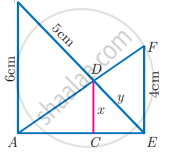
Solution
In the given diagram ∆AEF and ∆ACD
∠AEF = ∠ACD = 90°
∠A is common
By AA – Similarity.
∴ ∆AEF ~ ∆ACD
`"AE"/"AC" = "AF"/"AD" = "EF"/"CD"`
`"AE"/"AC" = "EF"/"CD"`
`"AE"/"AC" = 4/x`
AC = `("AE" xx x)/4` ...(1)
In ∆EAB and ∆ECD,
∠EAB = ∠ECD = 90°
∠E is common
∆ECD ~ ∆EAB
`"EC"/"EA" = "ED"/"EB" = "CD"/"AB"`
`"EC"/"EA" = x/6`
EC = `("EA" xx x)/6` ...(2)
In ∆AEB, CD || AB
By Basic Proportionality Theorem
`"AB"/"CD" = "EB"/"ED"`
`6/x = (5 + y)/y`
x = `(6y)/(y + 5)` ...(EC = x) ...(3)
Add (1) and (2) we get
AC + EC = `("AE" xx x)/4 + (x xx "EA")/6`
AE = `"AE"(x/4 + x/6)`
AE = `"AE"((3x + 2x)/12)`
AE = `"AE" xx ((5x)/12)`
∴ 1 = `(5x)/(12)`
⇒ 5x = 12
x = `(12)/(5)`
= 2.4 cm
Substitute the value of x = 2.4 in (3)
2.4 = `(6y)/(y + 5)`
6y = 2.4y + 12
6y – 2.4y = 12
⇒ 3.6 y = 12
y = `12/3.6 = 120/36 = 10/3` = 3.3 cm
The value of x = `12/5` or 2.4 cm and y = `10/3` or 3.3 cm
APPEARS IN
RELATED QUESTIONS
ΔABC~ΔPQR and ar(ΔABC) = 4, ar(ΔPQR) . If BC = 12cm, find QR.

O is any point in the interior of ΔABC. Bisectors of ∠AOB, ∠BOC and ∠AOC intersect side AB, side BC, side AC in
F, D and E respectively.
Prove that
BF × AE × CD = AF × CE × BD
Figure shows Δ PQR in which ST || QR and SR and QT intersect each other at M. If `"PT"/"TR" = 5/3` find `("Ar" (triangle "MTS"))/("Ar" (triangle "MQR"))`
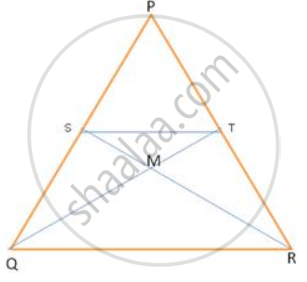
In the following figure, point D divides AB in the ratio 3 : 5. Find : `(AD)/(AB)`
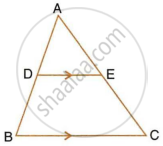
If ΔABC ~ ΔDEF, then writes the corresponding congruent angles and also write the ratio of corresponding sides.
Let ∆ ABC ∽ ∆ DEF and their areas be respectively, 64 cm2 and 121 cm2. If EF = 15⋅4 cm, find BC.
Points A(3, 1), B(5, 1), C(a, b) and D(4, 3) are vertices of a parallelogram ABCD. Find the values of a and b.
In the given figure, AB and DE are perpendicular to BC.
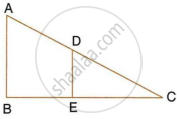
- Prove that ΔABC ∼ ΔDEC
- If AB = 6 cm, DE = 4 cm and AC = 15 cm. Calculate CD.
- Find the ratio of the area of a ΔABC : area of ΔDEC.
In the adjoining figure. BC is parallel to DE, area of ΔABC = 25 sq cm, area of trapezium BCED = 24 sq cm, DE = 14 cm. Calculate the length of BC.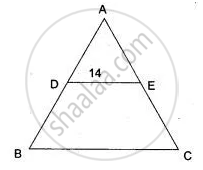
ΔABC has been reduced by a scale factor 0.6 to ΔA'B'C'/ Calculate:Length of B' C', if BC = 8cm
